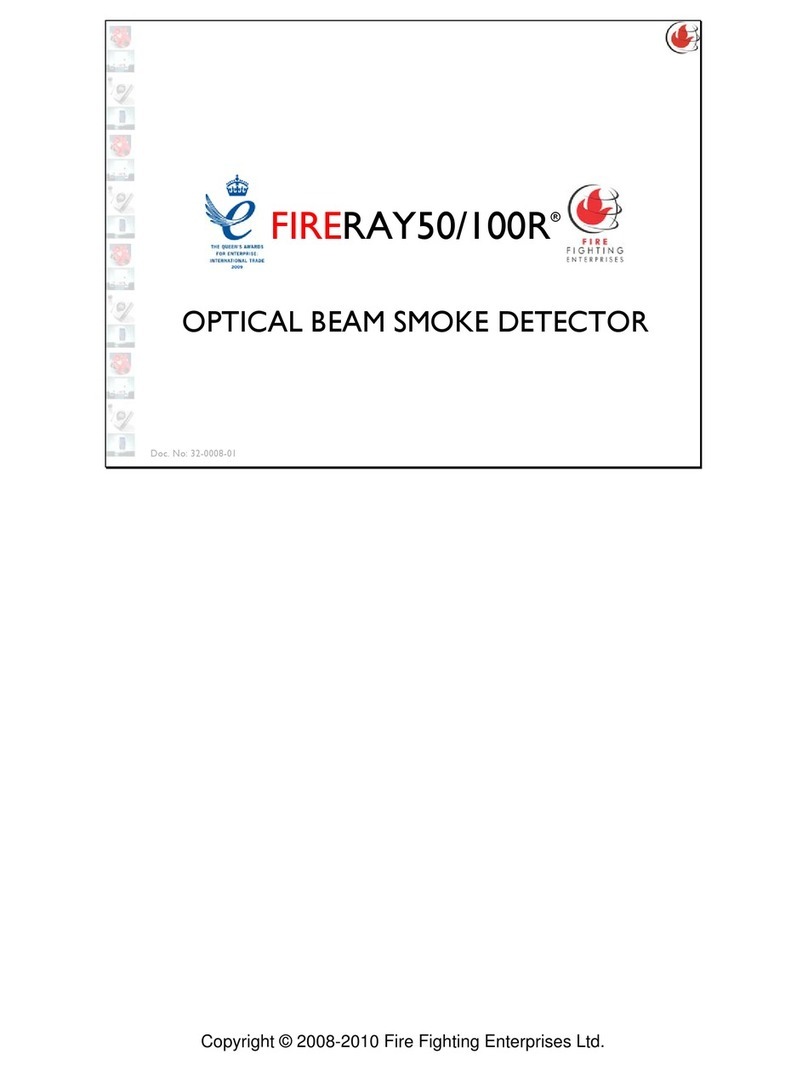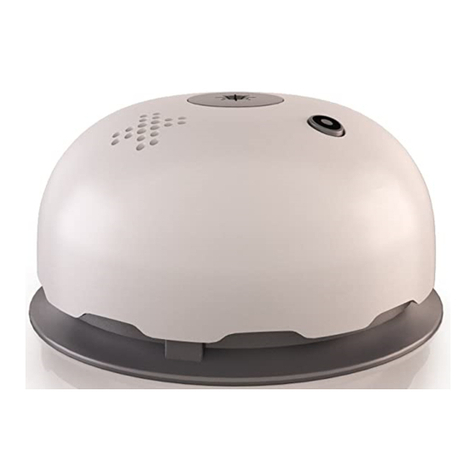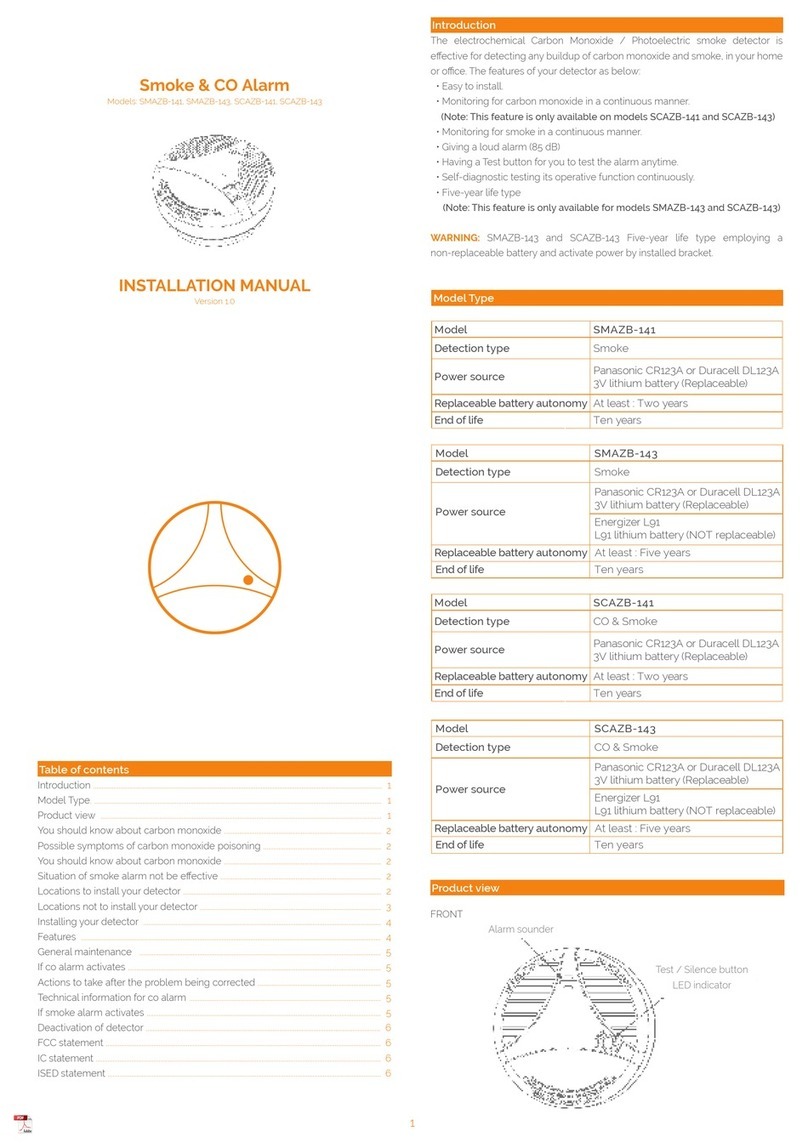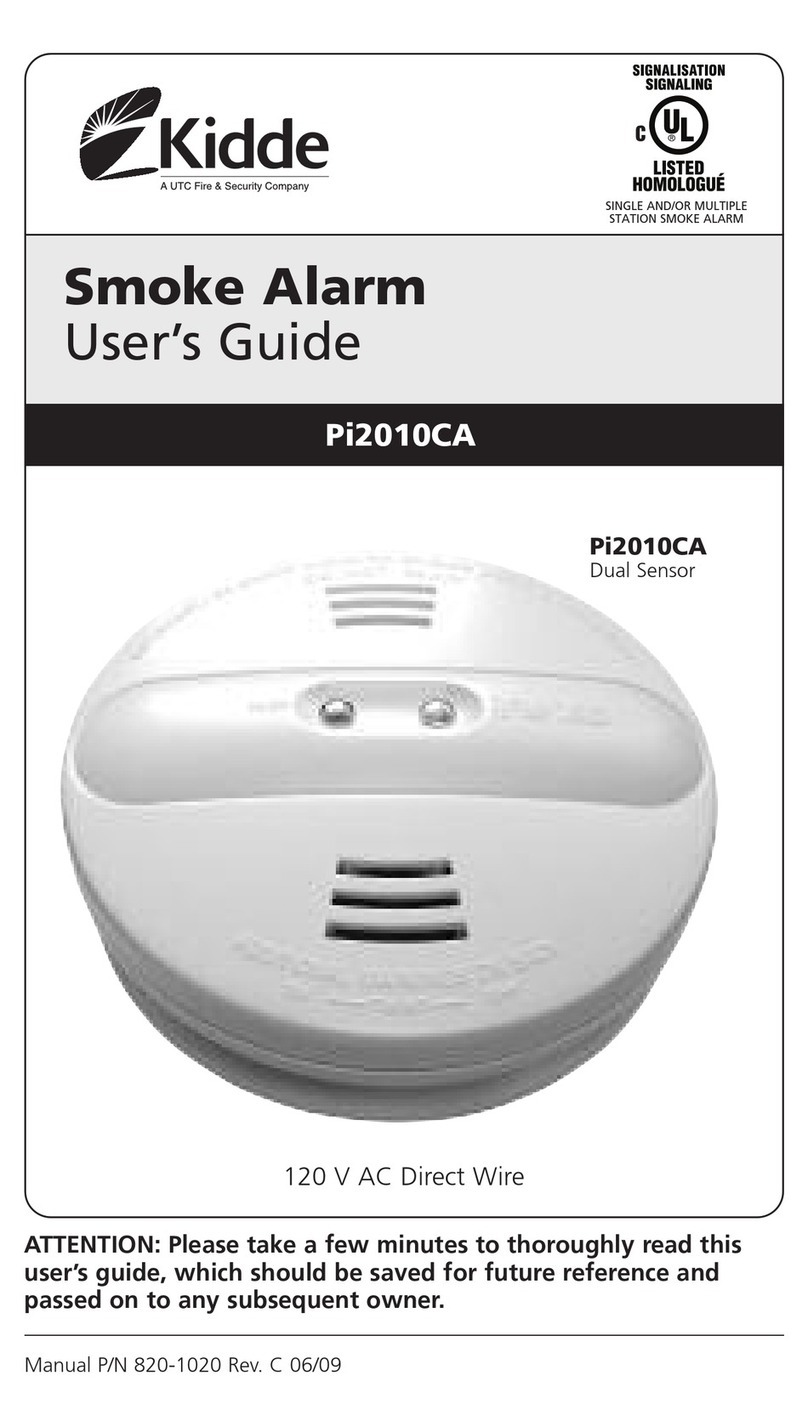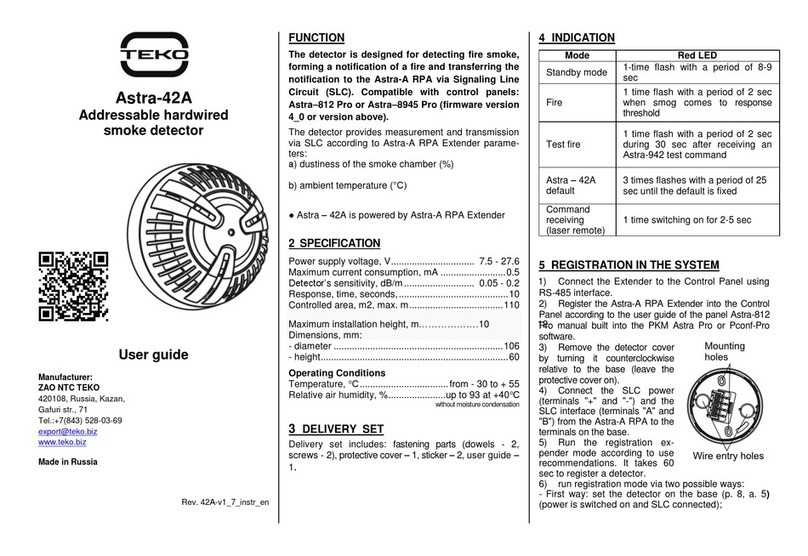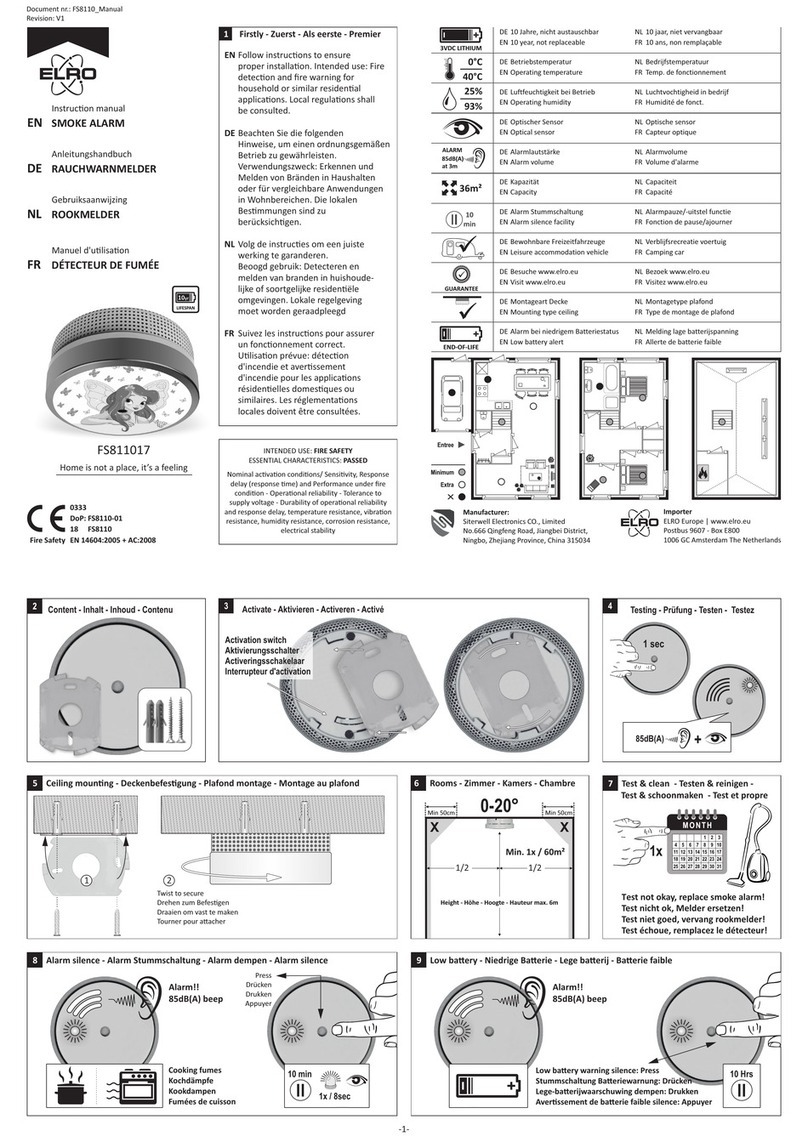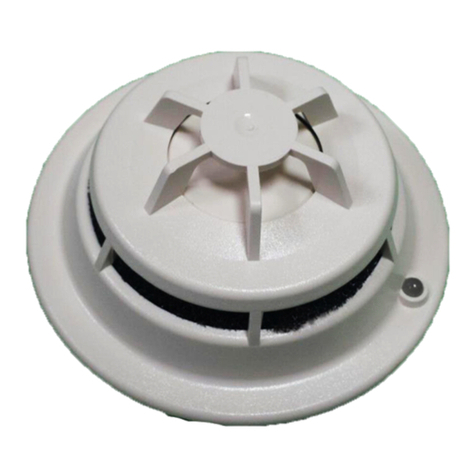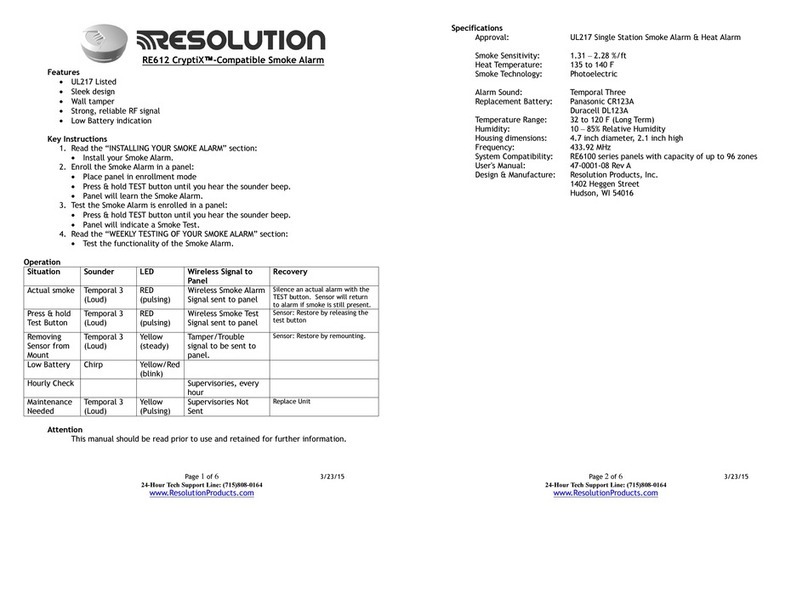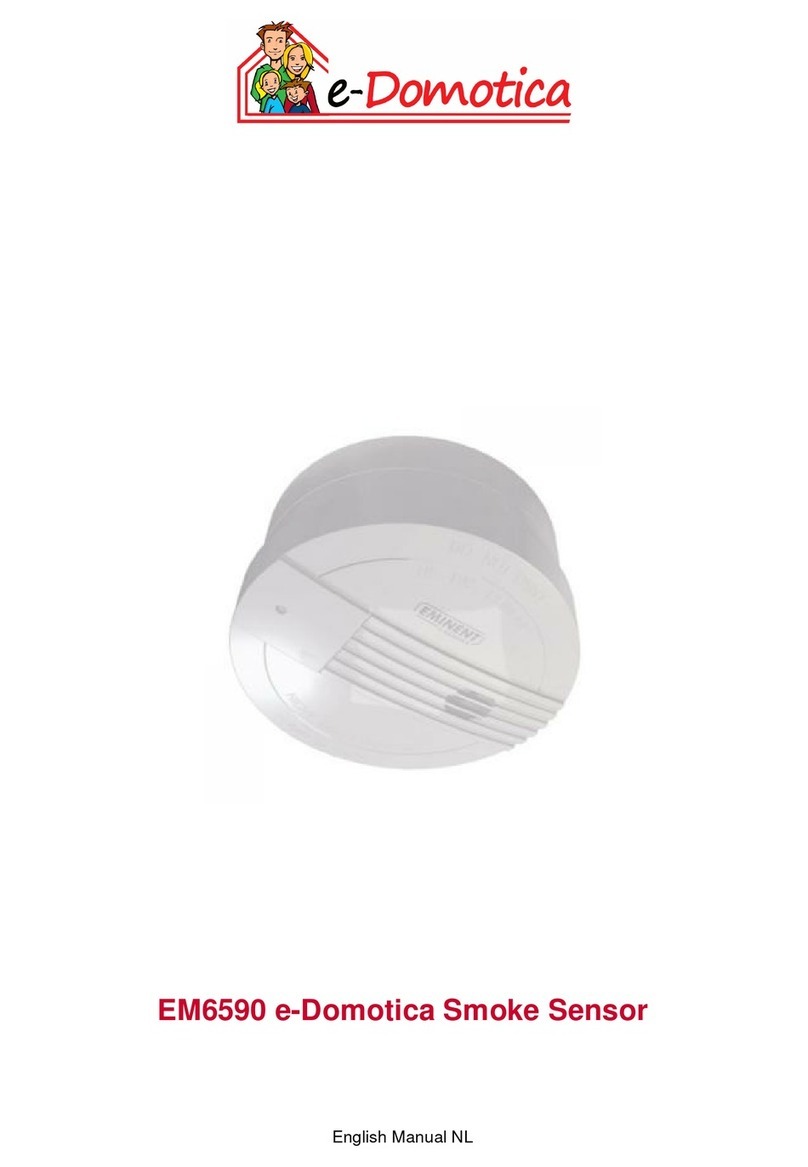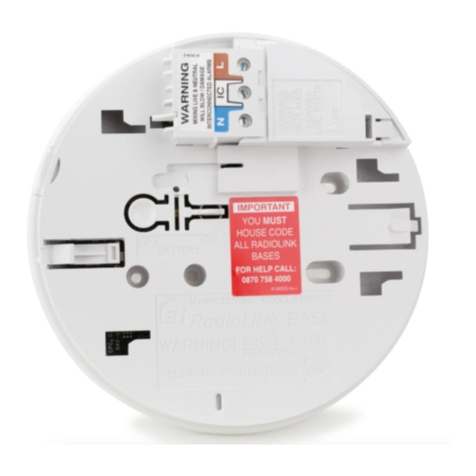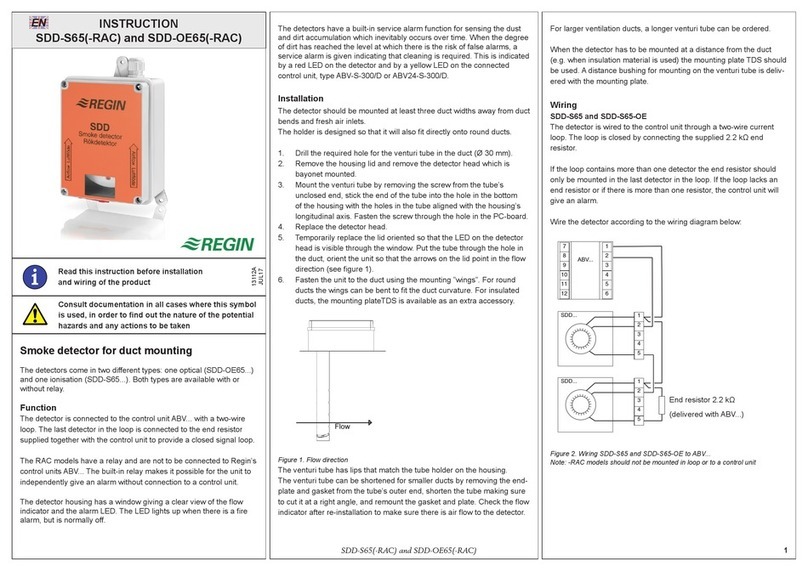Fire Fighting Enterprises FIRERAY 2000 EExd User manual

FIRERAY 2000 EExd
Hazardous Area Smoke Detector
Installation Guide
Page 1 of 14
** See specification on page 13 for technical details 23989.00.C (25.08.05)
♦ KEY FEATURES
⇒ Flameproof Receiver and Transmitter
⇒ Standard Fireray Controller Unit
⇒ High Coverage - up to 15002m per system
⇒ Low Cost
⇒ Beam Range 10 metres to 100 metres, in
normal use, 3m to 30 m retro operation.
⇒ 12 Volts dc to 24 Volts dc operation
⇒ Selectable Alarm Thresholds
⇒ Low Current Consumption
⇒ Manual or Automatic Fire Alarm Reset
⇒ Automatic Fault Alarm Reset
⇒ Ground Level Electronics
⇒ Extremely Rugged
⇒ Easy installation
⇒ Low maintenance
♦ APPLICATIONS
⇒ Zone 1 Environments
⇒ Refineries
⇒ Mills
⇒ Munitions Factories
⇒ Munitions Stores
⇒ Flammable Liquid Stores
⇒ Flammable Gas Stores
⇒ Flammable Powder Stores
⇒ Industrial Plants
⇒ Power Stations
⇒ Warehouses
⇒ Applications requiring highly rugged
detector heads
DESCRIPTION
The FIRERAY 2000 EExd SMOKE DETECTOR SYSTEM is designed primarily to protect EExd, IIB
hazardous areas.
It consists of a standard Fireray 2000 Controller/Analyser, combined with highly rugged flameproof
Transmitter and Receiver heads.
The Transmitter and Receiver Heads are designed to be mounted within the protected hazardous area,
whilst the Analyser is housed outside it. Using the Standard Analyser unit in this way allows a
significant cost reduction when compared to a system utilising flameproof enclosures for all
component parts. The maximum lateral beam coverage is 15m per Fireray System installed.
Once installed, the Transmitter Head projects a modulated Infra-Red Beam across the protected area, to
the Receiver head mounted opposite. The received signal strength is monitored and analysed in the
Ground Level Controller. Should the beam strength fall below the preset threshold for more than 8 -10
seconds, a Fire Alarm is signalled to the Control Equipment. The analyser also incorporates monitoring
for cable breaks or loss of function at the Transmitter or Receiver. If the signal strength is reduced
suddenly (<5 seconds) by greater than 93% a Fault Alarm is indicated to the Control equipment. The
Fire and Fault Alarm outputs are provided via two sets of Voltage-Free change-over relay contacts.
The Fire Alarm Relay may be set for latched or auto-reset operation as desired. The Fault Alarm is
designed to auto-reset once the signal is returned to serviceable limits.
The system may be used with ‘intelligent’ or ‘non-intelligent’ systems. Due to the very low current
consumption, back-up battery life is extended and the system may be powered from alarm loop
supplies in most cases.
PARTS LIST
1 x Transmitter Head (With Clear Lens)
1 x Receiver Head (With Dark Lens)
1 x Controller/Analyser Unit
1 x Adjustable Head Mounting Bracket
1 x Test Filter
1 x Installation Guide (This document)
1 x Atex Addendum Sheet 0600-(issue)
2 x Allen keys (5mm & 10mm)
1 x Bag of Bracket Fixings

FIRERAY 2000 EExd
Hazardous Area Smoke Detector
Installation Guide
Page 2 of 14
** See specification on page 13 for technical details 23989.00.C (25.08.05)
PRINCIPLE OF OPERATION
General
The Fireray system operates by passing an infra-red beam between a Transmitter and Receiver,
through the protected area. The received signal strength will be attenuated if smoke is present in the
beam. The beam strength is measured continuously and, should any attenuation be present which
exceeds presets thresholds, fire or fault alarms are generated as appropriate. Each installed Fireray can
cover an area 7.5 metres either side of the beam, giving a maximum coverage of up to 15002m with a
100m beam path length.
Transmitter and Receiver Units
A modulated Infra-Red light beam is projected from the Tx (Transmitter ) via it’s optical system. The
projected beam has a circular footprint, with a useable spread of approx 3m @ 100m range. The Rx
(Receiver) has a corresponding filtered optical system which collects and focuses the beam onto a
photo-detector. During installation, the Rx has a maximum beam acceptance angle of up to 5°
(dependant on gain and threshold settings). The wide Tx beam, in conjunction with the large Rx
acceptance angle simplifies alignment and gives good tolerance to beam mis-alignments after
installation.
Controller Unit And Alarm Thresholds
The signal received at the Rx is amplified and filtered to reject sunlight and other unwanted optical
noise such as may be caused by ambient lighting,. The signal is then passed to the Controller Unit,
where it undergoes further filtering and validity checking, before finally being analysed for signal
strength. The signal is then compared to a reference level (determined by the user’s threshold setting),
and should the signal be reduced below the set threshold, the FIRE ALARM relay will be activated
within approx 12 seconds. Three user selectable threshold setting are available **. Note that only one
threshold switch must be closed to select the required threshold. A red lamp on the Controller Unit
front panel also indicates a FIRE ALARM condition.
Controller Unit -Fault Thresholds
If the signal is reduced suddenly by more than 93% in 8 to 10 seconds, perhaps due to total beam
blockage, a cable break, or the Tx or Rx becoming unserviceable, the controller interprets this as a
fault situation. Loss of power to any of the system parts will also cause a fault signal to be generated.
In any of these events, the controller will activate the FAULT ALARM relay continuously. The system
will return to normal operation immediately, once the correct signals are restored, except in the event
of a power loss to the controller, in which case normal operation is resumed after 50 seconds from
restoration of power. A yellow lamp (LED4) in the Controller Unit also indicates when the system is in
a FAULT or RESET condition.
Controller Unit - Compensation (AGC) Operation And Action At Compensation Limit
The Controller Unit also incorporates an AGC (Automatic Gain Control) system **, which monitors
very slow changes in the received signal due to contamination of the optical system (EG: build up of
dust on the lenses) and any changes due to system ageing. If the signal is reduced by more than approx
11%, the AGC system is activated. Then if the signal is still low after 1.5 hours, a 7% increase is made
to the system gain, to bring the signal strength back into the nominal range. Additionally, should the
signal strength increase, perhaps due to improved alignment following building movement, the system
can reduce its gain in 7% steps. From an initial nominal setting, up to 11 increasing and 3 decreasing
correction steps are possible.

FIRERAY 2000 EExd
Hazardous Area Smoke Detector
Installation Guide
Page 3 of 14
** See specification on page 13 for technical details 23989.00.C (25.08.05)
Two possible actions are selectable, once the system has exhausted all compensation steps, as follows:-
• Leave the COMP switch in the Controller unit OPEN for BS5839 installations (UK). This
setting allows generation of a FIRE ALARM after reaching the compensation limit, even
though a FAULT ALARM will be active. This is the only time Fire and Fault indications
can occur together.
• Close the COMP switch if it is required that FIRE ALARM generation is inhibited once a
FAULT ALARM has occurred, due to reaching compensation limit.
Controller Unit - Relay Outputs
The Controller Unit has two sets of outputs for Fire and Fault indication, in the form of voltage free
single pole changeover relay contacts. The FIRE relay may be set to give either latching or non-
latching operation, determined by a switch (ALARM LATCH) on the Controller pcb. With the switch
closed, latching operation is selected.
Controller Unit - Signal Strength Metering
A ‘Metering ‘ output is also provided, to assist with installation. This gives a dc voltage which is
proportional to the received signal strength and can be monitored using a voltmeter.
Controller Unit - System Resetting
The system can be reset in any of three ways, as follows :-
• Using the RESET switch in the Controller Unit (Normally only used during installation).
• By taking the External Reset input low (to system 0V) for at least 5mS.
• By de-powering the system for 1 second, then re-powering.
Following a reset the system takes 50 seconds to self-calibrate. During this time the Fireray adjusts it’s
100% signal reference level and so must have a clear unobstructed beam. No tests should be carried
out until this initialisation period has elapsed.
Notes On Resetting Using The Internal RESET Switch
Note that for correct operation, the internal RESET switch must not be set to OFF whilst either of
the HIGH or LOW signal lamps in the Controller Unit are illuminated. The gain must be set
correctly to extinguish both lamps first. If this is not done the system AGC is locked and will not
operate. (This does not apply to the other two reset methods).
SUMMARY OF SYSTEM CONDITIONS :-
Possible Causes of FAULT Alarms
• Controller Unit RESET switch in ON position.
• Controller Unit EXTERNAL RESET input active ( at 0V)
• No power to Controller unit
• No Power to Tx unit
• Beam obscuration >93% for >5 seconds (for whatever reason)
• Tx or Controller power cable break.
• Receiver Signal cable break.
• AGC at limit of compensation.
• Rx/Tx Mis-alignment causing low signal strength

FIRERAY 2000 EExd
Hazardous Area Smoke Detector
Installation Guide
Page 4 of 14
** See specification on page 13 for technical details 23989.00.C (25.08.05)
• System unable to initialise following reset, due to inability to calibrate correctly (perhaps caused by
interference or testing of the beam before expiry of the 50 second calibration period.
• High or Low signal when Controller Unit’s RESET switch set to OFF (AGC locked out).
Possible Causes Of FIRE Alarms
• In normal use, beam strength reduced by more than the set threshold (Smoke in beam).
• During installation, no threshold switch set at the Controller Unit (One switch only must be set).
Possible Causes Of FIRE And FAULT Alarms Together
• AGC at limit of compensation, COMP switch OPEN (UK installations only) and beam strength
reduced by more than the set threshold.
PRECAUTIONS WHEN INSTALLING THE SYSTEM
Always ensure that the hazardous area into which the system will be installed is safe to work in, and
that neither you nor the installation will compromise the safety of that area.
Ensure that all mandatory and local regulations, regarding both fire alarm systems and EExd, IIB
applications, are adhered to.
Choose solid, stable surfaces on which to mount the Receiver and Transmitter.
If one of the mounting surfaces for the Transmitter or Receiver is likely to be susceptible to
movement, always mount the Transmitter on the more stable surface. The Receiver is less affected by
mis-alignments.
The beam should be positioned approx 30cm to 60cm below the ceiling, to avoid smoke layering or
masking effects.
Take precautions to position the beam such that it cannot be blocked during the normal course of
operations in the building.
Avoid mounting near or over heaters systems etc. Heat haze may cause obscuration and high levels of
beam ‘noise’.
If possible, avoid areas subject to thermal ‘shock’, such as near external loading bay doors etc. If
condensation forms on the lenses, this will be seen as an obscuration.
Avoid high intensity lighting near the receiver lens and avoid angling the Receiver directly at the sun.
The system incorporates circuitry to minimise effects due to high levels of ambient light (>15000 Lux),
but over heating of internal parts may occur with very strong sources, due to the focused beam within
the Receiver.
If possible, avoid bunching the system cables with factory power or other cabling.

FIRERAY 2000 EExd
Hazardous Area Smoke Detector
Installation Guide
Page 5 of 14
** See specification on page 13 for technical details 23989.00.C (25.08.05)
To achieve maximum EMI rejection, use screened cables for the system wiring, properly terminated at
metal glands (Do not use screen pigtails). MICC cable is recommended.
Use the correct EExd approved cable gland types for all system parts in the hazardous area.
Cables must be suitable for a minimum temperature of 101°C.
SETTING UP AND ALIGNING - DIRECT BEAM MODE
The Transmitter and Receiver heads must be positioned on stable, solid facing surfaces, such as
parallel walls, approx 0.3m to 0.6m below the area ceiling (See application notes near the end of this
guide). The surfaces must be parallel, vertically and horizontally within approx 20 degrees, although a
greater positioning range is possible (up to 40 degrees off line-of-sight) if the Receiver is also fitted it
with an Adjustable Mounting Bracket. This is available as an optional extra. If only small adjustments
are required, the Receiver line-of-sight may be adjusted by fitting spacer washers to it’s wall fixing
screws, between the Receiver Case and the mounting surface. (Some applications may require
fabrication of angled mounting brackets etc, in order to cope with awkward wall positions etc. These
are not supplied).
Install all required cabling to the defined positions for each system part. (See wiring diagram on
following page, for a typical installation). Ensure compliance with all regulatory and local
requirements for Hazardous Areas and Fire Alarm Systems. Approved screened cables and approved
EExd glands and termination methods must be used. Glands at the Controller, Rx and Tx must be
metal EExd types. The Cable screens or jackets must be terminated properly at the glands, with a 360°
termination. Screen Pigtails must not be used.
Mount the Receiver first, such that it faces, and has un-obstructed line of sight with the expected final
Transmitter position. Remove the Receiver housing top (using 5mm Allen key provided). Connect the
system cabling to the 3 way terminal block on the internal pcb. It is recommended that the External
Earth point be used on the Tx and Rx housings, to minimise wiring lengths. This must be taken to the
nearest suitable building Earth point. Alternatively, the housing’s Internal Earth stud may be
connected, via an additional cable core and connected back at the Control Unit Earth. (see wiring
diagram on the following page for connections and earthing regimes). Check the connections and
tighten the cable glands, then refit the housing top, taking care to position the ‘O’ ring seal correctly,
just below the flange. Tighten the 4 securing screws firmly. For safety reasons, and to give the best
EMI rejection, do not omit any of the Earth connections.
Fit the Transmitter head in a position which aligns as closely as possible with the Receiver line of
sight, making use of the adjustment bracket provided. A 12mm AF spanner/wrench is required for the
adjustment bolts. Remove the Transmitter housing top (using 5mm Allen key provided) and set the
Range Switch to the correct or next higher setting, to match the expected operating range. Use a biro
tip to set the switches. The switches are ‘ON’ when moved outward, and ‘OFF’ when moved inward,
toward the housing centre. Note that only one setting must be selected ‘ON’. Connect the system
cabling to the 3 way terminal block on the internal pcb and Earth the unit housing in the same manner
as used for the Rx (see wiring diagram on the following page for connections and earthing regimes).
Check the connections and tighten the cable glands, then refit the housing top, taking care to position
the ‘O’ ring seal correctly, just below the flange. Tighten the 4 securing screws firmly. For safety
reasons, and to give the best EMI rejection, do not omit any of the Earth connections.
Install and wire the Controller unit in it’s defined position, outside the hazardous area. Set the unit’s
Alarm threshold to 25%, 35% or 50%. Only close one switch position, for the desired threshold. Set
the ‘ALARM LATCH’ switch as required. Switch Closed = latching Fire Alarm operation. For UK

FIRERAY 2000 EExd
Hazardous Area Smoke Detector
Installation Guide
Page 6 of 14
** See specification on page 13 for technical details 23989.00.C (25.08.05)
installations, leave the ‘COMP’ switch open (Sets AGC operation at compensation limit - See
functional descriptions on page 2).
Check all wiring then apply power to all parts of the system.
At the Controller Unit, Set the Reset Switch to ‘ON’, and the Gain Control knob to approx midway.
Connect a length of two core bell wire or similar to the Metering terminals in the Control Unit. Run
this temporarily to the Transmitter position and connect a dc voltmeter to the ends. Set the voltmeter
to read up to 10Vdc or ‘autorange’.
Whilst observing the meter reading, adjust the Transmitter-to-Receiver alignment to achieve the
highest reading possible. A reading of at least 4.1Vdc is required for correct function (Note : <=2.7Vdc
= no signal). On completion, lock the transmitter adjustment bracket and all mountings securely,
checking the alignment on the meter whilst doing so. Remove the temporary meter wiring on
completion.
SETTING UP AND ALIGNING - RETRO-REFLECTED BEAM MODE
In this mode the beam is reflected from either a reflective prism or mirror. For most applications we
recommend using prisms, which are much easier to align. Prisms return the light beam along the same
axis as they receive it, whereas with a mirror the angle of reflection is the same as the angle of
incidence. Using a mirror, the beam may be reflected around structures or wall corners etc, however
setting up can be very difficult. Mirror applications are not covered in this document.
Using prsims, the installation and cabling is identical to that for the direct mode method except that the
Transmitter and Receiver must be mounted next to each other (as close as possible) and adjusted such
that both point at the prisms.
Choose Receiver and Transmitter mounting surfaces that are parallel to the prism mounting surface
within +/- 20°. If greater adjustment is required, then a second adjustable bracket may be fitted to the
Receiver (Optional extra)
Mount the Receiver first, such that it faces, and has un-obstructed line of sight with the expected prism
positions. Remove the Receiver housing top (using 5mm Allen key provided). Connect the system
cabling to the 3 way terminal block on the internal pcb. It is recommended that the External Earth point
be used on the Tx and Rx housings, to minimise wiring lengths. This must be taken to the nearest
suitable building Earth point. Alternatively, the housing’s Internal Earth stud may be connected, via an
additional cable core and connected back at the Control Unit Earth. (see wiring diagram on the
following page for connections and earthing regimes). Check the connections and tighten the cable
glands, then refit the housing top, taking care to position the ‘O’ ring seal correctly, just below the
flange. Tighten the 4 securing screws firmly. For safety reasons, and to give the best EMI rejection,
do not omit any of the Earth connections.
Fit the prisms on the opposing surface, ensuring (by eye) that they are perpendicular to, and centred
on, the Receiver lens central axis.
Mount the Transmitter on it’s adjustment bracket close alongside the Receiver, aligning it as closely as
possible with the prisms, making use of the movements provided. A 12mm AF spanner /wrench is
required for the adjustment bolts. Remove the Transmitter housing top (using 5mm Allen key
provided) and set the Range Switch to at least twice the range between the Tx/Rx and the prisms. Use
a biro tip to set the switches. The switches are ‘ON’ when moved outward, and ‘OFF’ when moved
inward, toward the housing centre. Note that only one setting must be selected ‘ON’. Connect the

FIRERAY 2000 EExd
Hazardous Area Smoke Detector
Installation Guide
Page 7 of 14
** See specification on page 13 for technical details 23989.00.C (25.08.05)
system cabling to the 3 way terminal block on the internal pcb and Earth the unit housing in the same
manner as used for the Rx (see wiring diagram on the following page for connections and earthing
regimes). Check the connections and tighten the cable glands, then refit the housing top, taking care to
position the ‘O’ ring seal correctly, just below the flange. Tighten the 4 securing screws firmly. For
safety reasons, and to give the best EMI rejection, do not omit any of the Earth connections.
Install and wire the Controller unit in it’s defined position, outside the hazardous area. Set the unit’s
Alarm threshold to 25%, 35% or 50%. (50% recommended, which is approximately equivalent to a
25% setting in direct mode) Only close one switch position, for the desired threshold. Set the
‘ALARM LATCH’ switch as required. Switch Closed = latching Fire Alarm operation. For UK
installations, leave the ‘COMP’ switch open (Sets AGC operation at compensation limit - See
functional descriptions on page 2).
Check all wiring then apply power to all parts of the system.
At the Controller Unit, Set the Reset Switch to ‘ON’, and the Gain Control to approx midway.
With the system installed and powered up, monitor the signal strength using a voltmeter (10Vdc range
or ‘autorange’) connected to the Controller unit’s METER + and - terminals.
Whilst observing the meter reading, adjust the Transmitter-to-prism alignment to achieve the highest
reading possible. A reading of at least 4.1Vdc is required for correct function (Note : <=2.7Vdc = no
signal). On completion, lock the transmitter adjustment bracket and all mountings securely, checking
the alignment on the meter whilst doing so. Note that, as for the direct mode installation, a Fireray
Alignment Aid may be used in place of the Voltmeter, aligning for the highest flash rate. Remove the
temporary meter wiring on completion.
Return to the Controller Unit and observe the Green lamps either side of the Gain Control. Adjust the
Gain Control such that the two lamps both extinguish completely.
Set the Controller unit’s Reset Switch to ‘OFF’, observe that the yellow FAULT lamp extinguishes,
then wait at least 50 seconds while the system calibrates. After 50 seconds, check that the FAULT
lamp is still extinguished. The system is now armed and active.
TESTING THE SYSTEM
Following installation, test the system as follows :-
First ensure that the system is running and has been allowed time to calibrate (50 seconds after power-
up or reset).
Fire Alarm
• Place the striped end of the test filter over the Receiver lens.
• A Fire Alarm shall be indicated in approx 10 to 12 seconds.
Fault Alarm
• Place a complete blockage (example: a hand) over the Receiver lens. Ensure that the lens is
fully covered.
• A Fault Alarm shall be indicated in approx 4 to 6 seconds.
For Retro operation only

FIRERAY 2000 EExd
Hazardous Area Smoke Detector
Installation Guide
Page 8 of 14
** See specification on page 13 for technical details 23989.00.C (25.08.05)
• To check that the beam is being reflected by the prisms, rather than some other reflective
surface, block off the beam completely at the prisms using a suitable non-reflective blind
(sheet of black cardboard or similar). A Fault Alarm shall be indicated in approx 4 to 6
seconds.

FIRERAY 2000 EExd
Hazardous Area Smoke Detector
Installation Guide
Page 9 of 14
** See specification on page 13 for technical details 23989.00.C (25.08.05)
Rx
HIGH
LAMP
LOW
LAMP
RELAY WIRING,
CONNECT AS REQUIRED
TO INDICATING
E
Q
UIPMENT
TEST/RESET
⇐
ON OFF
⇒
SW5
+V Rx
SIGNAL Rx
0V Rx
TEST
METER
EXTERNAL
RESET
-
+
0V
+VE
OPTIONAL
TRANSMITTER P.S.U
(OR USE CONTROLLER
AND RECEIVER P.S.U)
12Vdc TO 24Vdc
-
N/O
100MA (T)
0V
+VE
CONTROLLER AND
RECEIVER P.S.U
12Vdc TO 24Vdc
ALARM
N/C
CO
N/O
N/C
CO
F
A
U
L
T
A
L
A
R
M
SIGNAL LEVEL
+
COMP
25%
35%
50%
EExd
GLAND
EExd
GLAND
METAL
GLAND
METAL
GLAND METAL
GLAND
METAL
GLAND
OPTIONAL REMOTE
RESET WIRING
(
SEE TEXT
)
CLOSE TO
RESET
HAZARDOUS ⇐
AREA ⇒NON-HAZARDOUS
AREA
METAL EExd
GLAND
Tx
METAL EExd
GLAND
Rx EXTERNAL CASE
EARTH (SEE TEXT)
Tx EXTERNAL
CASE EARTH (SEE
SUPPLY
12Vdc
TO
24Vdc
FAULT
LAMP
LED1 LED2
LED4
F
US
E
CONTROLLER UNIT/PCB
• Typical installation shown (See text).
• Do not omit any Earth connections.
• MICC cable recommended for all cabling.
• Approved, EExd glands must be used at the Rx
and Tx, and at the interface partitioning the
hazardous and non-hazardous areas.
1
0
0
m
m
a
x

FIRERAY 2000 EExd
Hazardous Area Smoke Detector
Installation Guide
Page 10 of 14
** See specification on page 13 for technical details 23989.00.C (25.08.05)
1020406080100
TRANSMITTER REQUIRES 2 CORE SCREENED WIRING
TO SUITABLE POWER SUPPLY, PLUS ENCLOSURE
EARTH BONDING.
THE ENCLOSURE EARTH BOND MAY BE CONNECTED
TO THE INTERNAL OR EXTERNAL EARTH TERMINALS
AND MUST NOT BE OMITTED.
-VE +VE
Do not route wiring within the
50mm circular central area, to avoid
obscuring optical components
Internal Earth stud
will be found in one
of these two positions
External Earth terminal will be
found in one of these two positions
User wiring terminals.
Wire only to the -VE and +VE
terminals. (Middle ‘SIG’ terminal
not used on Transmitter units)
User wiring to enter here, via suitable
EExd IIB or IIC approved gland.
VIEW INSIDE TRANSMITTER UNIT WITH TOP WINDOW SECTION REMOVED
SHOWING TERMINALS AND SETTINGS ETC
note: some components not shown for clarity
REF:
Range switch shown set to
100m. Only one switch position
to be ON at a time
Do not use this hole for cable entry
(EExd blanking plug fitted at factory)

FIRERAY 2000 EExd
Hazardous Area Smoke Detector
Installation Guide
Page 11 of 14
** See specification on page 13 for technical details 23989.00.C (25.08.05)
-VE +VE
Do not route wiring within the
50mm circular central area, to avoid
obscuring optical components
Internal Earth stud
will be found in one
of these two positions
External Earth terminal will be
found in one of these two positions
User wiring to enter here, via suitable
EExd IIB or IIC approved gland.
VIEW INSIDE RECEIVER UNIT WITH TOP WINDOW SECTION REMOVED
SHOWING TERMINALS AND SETTINGS ETC
note: some components not shown for clarity
SIG
RECEIVER REQUIRES 3 CORE SCREENED WIRING TO
CONTROLLER UNIT, PLUS ENCLOSURE EARTH BONDING.
THE ENCLOSURE EARTH BOND MAY BE CONNECTED TO
THE INTERNAL OR EXTERNAL EARTH TERMINALS
AND MUST NOT BE OMITTED.
User wiring
terminals. Connect
back to Controller
Unit via suitable
EExd cabling.
Do not use this hole for cable entry
(EExd blanking plug fitted at
factory)

FIRERAY 2000 EExd
Hazardous Area Smoke Detector
Installation Guide
Page 12 of 14
** See specification on page 13 for technical details 23989.00.C (25.08.05)
Tx
Tx
Tx
10°
SINGLE BEAM MULTIPLE BEAMS
SEE NOTE 3
15m MAX 30m MAX. OVER 30m
7.5m 7.5m 0.5m MIN. 15m 15m
A ceiling or roof with a slope in excess of 3.5 degrees should be regarded as an apex roof.
N
ote 3: No more than 3m of the beam path should be within 500mm of any wall or partitions.
When Firerays are mounted in the apex the horizontal distance may increase by 1% for each degree of ceiling
slope, up to 25% maximum, (for Fireray in apex only).
APEX CEILINGS
10° SLOPING ROOF 30° SLOPING ROOF
7.5m 7.5m+8.25m 8.25m+7.5m 7.5m 18.75m MAX.
(7.5 + 7.5 x 2.5%)
SLOPING CEILINGS
7.5m 15m 0.5m
SEE NOTE 3
RECEIVER AND TRANSMITTER SHOULD BE POSITIONED 0.3m TO 0.6m BELOW THE CEILING
Tx Tx
Tx Tx
20°
Tx Tx Tx Tx Tx Tx
0.5m MIN.
30°

FIRERAY 2000 EExd - SYSTEM SPECIFICATION
Page 13 of 14
SYSTEM TYPE
Transmitter (TX) Rugged for EExd IIB areas - IP67
Receiver (RX) Rugged for EExd IIB areas - IP67
Controller (CU) Designed to be sited outside the hazardous
area. Rugged for light industrial and
domestic use - IP50
CERTIFICATION
SIRA03ATEX1504
CONFORMS WITH
EExd General
requirements) BS EN 50014 : 1998
EExd enclosures BS EN 50018 : 2000
Fire Alarm Systems BS 5839 : Pt 5 : 1988
Emc Immunity BS EN 61000-6-2:1999
Emc Emissions BS EN 61000-6-4:2001
Alarm Systems - EMC BS EN 50130-4 1996
ATEX Directive 94/9/EC
TEMPERATURE
Range -20°C to +55°C
THRESHOLDS
Alarm 25%, 35% or 50%**, switch selectable
(1.25db, 1.87db or 3.01db**)
** For full compliance with BS5839 Pt.5,
use 25% and 35% thresholds. 50% threshold
is normally recommended for retro mode.
Fault >=93% (11.55db), fixed
DETECTION TIMES
Fire 10 seconds (min)
Fault 5 seconds (min)
SYSTEM RANGE
Minimum 10m (3m in ‘Retro’ mode)
Maximum 100m (30m in ‘Retro’ mode)
RETRO PRISMS Use Part No: 23901
Range 3m to 5m use 2 prisms
6m to 10m use 4 prisms (Square)
11m to 30m use 6 prisms (Rectangle)
TRANSMITTER
Type Pulsed, Focused Infra-Red beam
Beam Half-Angle 1°approx
Spectrum Nominally 880Nm (Near Infra-Red)
Max IR O/P (mean) 6.4mW/Sr at IR LED
Max IR O/P (peak) 800mW/Sr at IR LED
Misalignment angle @25% and (@ 50%) threshold settings
During installation +/-1°(+/-1°) for a measurable signal
After installation +/-0.5°(+/-0.75°) (After perfect alignment)
Connections 2 wire, power only required - no connection
to other system parts necessary
RECEIVER
Misalignment angle @25% and (@ 50%) threshold settings
During installation +/-4°(+/-5°) for a measurable signal
After installation +/-3°(+/-4°) (After perfect alignment)
Connections 3 wire, connected to Controller Unit only
SUPPLY VOLTAGES (At each detector component)
Tx (nominal) +12Vdc to +24Vdc
Tx (min/max) +11.5Vdc to +28Vdc
Control/Rx (nominal) +12Vdc to +24Vdc
Control/Rx (min/max) +11.5Vdc to +28Vdc
Rx N/A, Supplied from Control Unit
SUPPLY CURRENT
Control/Rx (Normal) 7.5mA @ all ranges
Control/Rx (Alarm) 13.5mA @ all ranges
Tx 1.6mA @10m to 5.6mA max @100m
SUPPLY RIPPLE
Tx 0.5V p-p min, sine, 50-100Hz @11.5Vdc
Immunity increases with higher supply
voltage
Control/Rx 0.5V p-p min, sine, 50-100Hz @11.5Vdc
Immunity increases with higher supply
voltage
SYSTEM RESET
Internal Via slider switch in controller unit
External (1) Remote Reset input - Ground for >5mS
External (2) Power break for 1 second then re-power
INITIALISATION
TIME
Following reset 50 seconds
SYSTEM OUTPUTS
Fire Alarm Voltage-Free SPCO contacts, switch
selectable for latching or auto-reset
operation.
Fault Alarm Voltage-Free SPCO contacts, auto-resetting
operation
Contact ratings 1.0A @ 24Vdc (resistive)
0.3A @ 24Vdc (Inductive)
0.5A @ 120Vac (resistive)
0.2A @ 120Vac(inductive)
Meter Output DC output proportional to signal strength,
for alignment and maintenance check
purposes
Meter Range
No signal
Low signal
Normal signal
High signal
2.7Vdc to 6Vdc approx
2.7Vdc
>2.7Vdc to <4.1Vdc
4.25Vdc +/-0.15Vdc
> 4.4Vdc
COMPENSATION (AGC)
Function Detects and corrects for Rx/Tx lens
contamination, or minor gain errors after
installation or reset.
Update Period Every 1.5 hours
Correction step Approx 7% per step
Correction Range Approx -28% to +77% (% with respect to
initial setting)
SYSTEM CABLING
Max Cable Run 100m to any system part
Cable Type Screened (MICC recommended)
Max Capacitance 100pF/m
SIZES
Controller 215mm x 265mm x 88mm
Heads 120mm x 125mm x 125mm
Brackets 172mm x 124mm x 56mm
WEIGHTS
Controller 1060 grammes
Tx 2140 grammes
Rx 2165 grammes
Brackets 1530 grammes
FINISH
Controller White Powder Coat, to RAL 9010
Heads Red Powder Coat to RAL 2002
Brackets Red Powder Coat to RAL 2002
STATEMENT OF INTENDED USE
This system is intended for use as a Smoke Detector only, in EExd IIB, or lower grade areas. It must not be used in areas with a greater hazard rating.
It must be installed and tested by approved, competent personnel, in accordance with all regulatory and local codes of practise. No liability shall be
accepted for installations not conforming to this requirement.
WARNING
The area into which the Fireray parts are to be fitted must be made safe before attempting any work on the system. It must also be checked
thoroughly prior/during/after commissioning, to ensure it cannot compromise the safety of the area in which it is fitted. Note that only the
Transmitter and Receiver parts may be installed in the hazardous area, NOT the Controller Unit.
23989.00.C (Jan 04)

Page 14 of 14
** See specification on page 13 for technical details 23989.00.C (25.08.05)
Fire Fighting Enterprises Ltd.
9 Hunting Gate, Hitchin
Hertfordshire SG4 0TJ England
Tel: +44 (0) 845 4024242
Fax: +44 (0) 845 4024201
Email: [email protected]
www.ffeuk.com
Table of contents
Other Fire Fighting Enterprises Smoke Alarm manuals

